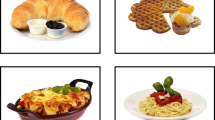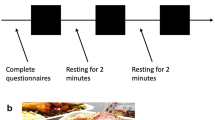Abstract
Heart rate variability (HRV) biofeedback has been reported to increase HRV while decreasing symptoms in patients with mental disorders. In addition, associations between low HRV and lowered self-regulation were found in non-clinical samples, e.g., in individuals with strong chocolate cravings or unsuccessful dieting. The current study aimed at decreasing food cravings with HRV-biofeedback in individuals frequently experiencing such cravings. Participants (N = 56) with strong or low food cravings associated with a lack of control over eating were selected from the local community. Half of the participants with strong cravings (craving-biofeedback; n = 14) performed 12 sessions of HRV-biofeedback while the other half (craving-control; n = 14) and a group with low cravings (non-craving-control; n = 28) received no intervention. Subjective food cravings related to a lack of control over eating decreased from pre- to post-measurement in the craving-biofeedback group, but remained constant in the control groups. Moreover, only the craving-biofeedback group showed a decrease in eating and weight concerns. Although HRV-biofeedback was successful in reducing food cravings, this change was not accompanied by an increase in HRV. Instead, HRV decreased in the craving-control group. This study provides preliminary evidence that HRV-biofeedback could be beneficial for attenuating dysfunctional eating behavior although specific mechanisms remain to be elucidated.


Similar content being viewed by others
Notes
Initially, participants who were identified as high cravers were randomly assigned to either the biofeedback or the control group. However, when participants assigned to the biofeedback group were contacted and told that the study would require several lab visits for 4 weeks (further details were not mentioned), n = 3 participants indicated that they could not participate in the study because of time constraints. Those participants were then assigned to the control group.
References
Abler, B., & Kessler, H. (2009). Emotion regulation questionnaire—A German version of the ERQ by Gross and John. Diagnostica, 55, 144–152.
Appelhans, B. M., & Luecken, L. J. (2006). Heart rate variability as an index of regulated emotional responding. Review of General Psychology, 10, 229–240.
Blechert, J., Michael, T., Grossman, P., Lajtman, M., & Wilhelm, F. H. (2007). Autonomic and respiratory characteristics of posttraumatic stress disorder and panic disorder. Psychosomatic Medicine, 69, 935–943.
Britton, A., & Hemingway, H. (2004). Heart rate variability in healthy populations: Correlates and consequences. In M. Malik & J. Camm (Eds.), Dynamic electrocardiography (pp. 90–111). Oxford: Blackwell.
Cepeda-Benito, A., Gleaves, D. H., Williams, T. L., & Erath, S. A. (2000). The development and validation of the state and trait Food-Cravings Questionnaires. Behavior Therapy, 31, 151–173.
Cohen, J. (1988). Statistical power analysis for the behavioral sciences (2nd ed.). Hillsdale, NJ: Lawrence Erlbaum Associates.
Coles, J., Vögele, C., Hilbert, A., & Tuschen-Caffier, B. (2005). Fasting and (over)eating: Effects of yoyo diets on measures of cardiac sympathovagal balance. Zeitschrift für Klinische Psychologie und Psychotherapie, 34, 95–103.
Fairburn, C. G., & Beglin, S. J. (1994). Assessment of eating disorders: Interview or self-report questionnaire? International Journal of Eating Disorders, 16, 363–370.
Fishbach, A., Friedman, R. S., & Kruglanski, A. W. (2003). Leading us not unto temptation: Momentary allurements elicit overriding goal activation. Journal of Personality and Social Psychology, 84, 296–309.
Friederich, H. C., Schild, S., Schellberg, D., Quenter, A., Bode, C., Herzog, W., et al. (2006). Cardiac parasympathetic regulation in obese women with binge eating disorder. International Journal of Obesity, 30, 534–542.
Gearhardt, A. N., Corbin, W. R., & Brownell, K. D. (2009). Preliminary validation of the Yale Food Addiction Scale. Appetite, 52, 430–436.
Gross, J. J., & John, O. P. (2003). Individual differences in two emotion regulation processes: Implications for affect, relationships, and well-being. Journal of Personality and Social Psychology, 85(2), 348–362.
Hilbert, A., & Tuschen-Caffier, B. (2006). Eating disorder examination—questionnaire: Deutschsprachige Übersetzung. Münster: Verlag für Psychotherapie.
Hilbert, A., Tuschen-Caffier, B., Karwautz, A., Niederhofer, H., & Munsch, S. (2007). Eating disorder examination-questionnaire: Psychometric properties of the German version. Diagnostica, 53, 144–154.
Hinz, A., & Brähler, E. (2011). Measurement changes in clinical psychological questionnaires. Psychotherapie, Psychosomatik, Medizinische Psychologie, 61, 333–334.
Holroyd, K. A., Penzien, D. B., Hursey, K. G., Tobin, D. L., Rogers, L., Holm, J. E., et al. (1984). Change mechanisms in EMG biofeedback training: Cognitive changes underlying improvements in tension headache. Journal of Consulting and Clinical Psychology, 52, 1039–1053.
Ingjaldsson, J. T., Thayer, J. F., & Laberg, J. C. (2003). Craving for alcohol and pre-attentive processing of alcohol stimuli. International Journal of Psychophysiology, 49, 29–39.
Karason, K., Molgaard, H., Wikstrand, J., & Sjostrom, L. (1999). Heart rate variability in obesity and the effect of weight loss. American Journal of Cardiology, 83, 1242–1247.
Karavidas, M. K., Lehrer, P. M., Vaschillo, E., Vaschillo, B., Marin, H., Buyske, S., et al. (2007). Preliminary results of an open label study of heart rate variability biofeedback for the treatment of major depression. Applied Psychophysiology and Biofeedback, 32(1), 19–30.
Krampen, G. (1981). IPC-Fragebogen zu Kontrollüberzeugungen. Göttingen: Hogrefe.
Kühn, S., & Gallinat, J. (2011). Common biology of craving across legal and illegal drugs—a quantitative meta-analysis of cue-reactivity brain response. European Journal of Neuroscience, 33, 1318–1326.
Lacroix, J. M., Clarke, M. A., Bock, J. C., & Doxey, N. C. (1986). Physiological changes after biofeedback and relaxation training for multiple-pain tension-headache patients. Perceptual and Motor Skills, 63, 139–153.
Latchman, P. L., Mathur, M., Bartels, M. N., Axtell, R. S., & De Meersman, R. F. (2011). Impaired autonomic function in normotensive obese children. Clinical Autonomic Research, 21, 319–323.
Lehrer, P. M., Vaschillo, E., Lu, S. E., Eckberg, D., Vaschillo, B., Scardella, A., et al. (2006). Heart rate variability biofeedback—Effects of age on heart rate variability, baroreflex gain, and asthma. Chest, 129, 278–284.
Lehrer, P. M., Vaschillo, E., & Vaschillo, B. (2000). Resonant frequency biofeedback training to increase cardiac variability: Rationale and manual for training. Applied Psychophysiology and Biofeedback, 25, 177–191.
Lehrer, P. M., Vaschillo, E., Vaschillo, B., Lu, S. E., Eckberg, D. L., Edelberg, R., et al. (2003). Heart rate variability biofeedback increases baroreflex gain and peak expiratory flow. Psychosomatic Medicine, 65, 796–805.
Levenson, H. (1973). Reliability and validity of the I, P, and C scales—A multidimensional view of locus of control. Paper presented at the American Psychologcial Association Convention, Montreal, Canada.
Löllgen, D., Mück-Weymann, M., & Beise, R. (2009). The deep breathing test: Median-based expiration-inspiration difference is the measure of choice. Muscle and Nerve, 39, 536–544.
Mazurak, N., Enck, P., Muth, E., Teufel, M., & Zipfel, S. (2011). Heart rate variability as a measure of cardiac autonomic function in anorexia nervosa: A review of the literature. European Eating Disorders Review, 19, 87–99.
Meule, A., Lutz, A., Vögele, C., & Kübler, A. (in revision). Self-reported dieting success is associated with cardiac autonomic regulation in current dieters.
Meule, A., Lutz, A., Vögele, C., & Kübler, A. (2012a). Food cravings discriminate differentially between successful and unsuccessful dieters and non-dieters. Validation of the Food Craving Questionnaires in German. Appetite, 58, 88–97.
Meule, A., Papies, E. K., & Kübler, A. (2012b). Differentiating between successful and unsuccessful dieters: Validity and reliability of the perceived self-regulatory success in dieting scale. Appetite, 58, 822–826.
Meule, A., Skirde, A. K., Freund, R., Vögele, C., & Kübler, A. (in press-b). High-calorie food-cues impair working memory performance in high and low food cravers. Appetite.
Meule, A., Vögele, C., & Kübler, A. (2012c). Restrained eating is related to accelerated reaction to high caloric foods and cardiac autonomic dysregulation. Appetite, 58, 638–644.
Meule, A., Vögele, C., & Kübler, A. (in press-a). German translation and validation of the Yale Food Addiction Scale. Diagnostica.
Meule, A., Westenhöfer, J., & Kübler, A. (2011). Food cravings mediate the relationship between rigid, but not flexible control of eating behavior and dieting success. Appetite, 57, 582–584.
Pelchat, M. L., Johnson, A., Chan, R., Valdez, J., & Ragland, J. D. (2004). Images of desire: Food-craving activation during fMRI. NeuroImage, 23, 1486–1493.
Rodríguez-Ruiz, S., Guerra, P. M., Moreno, S., Fernández, M. C., & Vila, J. (2012). Heart rate variability modulates eye-blink startle in women with bulimic symptoms. Journal of Psychophysiology, 26, 10–19.
Rodríguez-Ruiz, S., Ruiz-Padial, E., Vera, N., Fernández, C., Anllo-Vento, L., & Vila, J. (2009). Effect of heart rate variability on defensive reaction and eating disorder symptomatology in chocolate cravers. Journal of Psychophysiology, 23, 95–103.
Sharp, C., Hurford, D. P., Allison, J., Sparks, R., & Cameron, B. P. (1997). Facilitation of internal locus of control in adolescent alcoholics through a brief biofeedback-assisted autogenic relaxation training procedure. Journal of Substance Abuse Treatment, 14, 55–60.
Siepmann, M., Aykac, V., Unterdörfer, J., Petrowski, K., & Mueck-Weymann, M. (2008). A pilot study on the effects of heart rate variability biofeedback in patients with depression and in healthy subjects. Applied Psychophysiology and Biofeedback, 33, 195–201.
Tan, G., Dao, T. K., Farmer, L., Sutherland, R. J., & Gevirtz, R. (2011). Heart rate variability (HRV) and posttraumatic stress disorder (PTSD): A pilot study. Applied Psychophysiology and Biofeedback, 36, 27–35.
Tarvainen, M. P., Niskanen, J.-P., Lipponen, J. A., Ranta-Aho, P. O., & Karjalainen, P. A. (2009). Kubios HRV—a software for advanced heart rate variability analysis. In J. Vander Sloten, P. Verdonck, M. Nyssen, & J. Haueisen (Eds.), ECIFMBE 2008, IFMBE proceedings 22 (pp. 1022–1025). Berlin, Heidelberg: Springer.
Task Force of The European Society of Cardiology and The North American Society of Pacing and Electrophysiology. (1996). Heart rate variability: Standards of measurement, physiological interpretation, and clinical use. European Heart Journal, 17, 354–381.
Thayer, J. F., Hall, M., Sollers, J. J., & Fischer, J. E. (2006). Alcohol use, urinary cortisol, and heart rate variability in apparently healthy men: Evidence for impaired inhibitory control of the HPA axis in heavy drinkers. International Journal of Psychophysiology, 59, 244–250.
Thayer, J. F., & Lane, R. D. (2009). Claude Bernard and the heart-brain connection: Further elaboration of a model of neurovisceral integration. Neuroscience and Biobehavioral Reviews, 33, 81–88.
Thayer, J. F., Yamamoto, S. S., & Brosschot, J. F. (2010). The relationship of autonomic imbalance, heart rate variability and cardiovascular disease risk factors. International Journal of Cardiology, 141, 122–131.
Vaschillo, E., Lehrer, P., Rishe, N., & Konstantinov, M. (2002). Heart rate variability biofeedback as a method for assessing baroreflex function: A preliminary study of resonance in the cardiovascular system. Applied Psychophysiology and Biofeedback, 27, 1–27.
Vaschillo, E., Vaschillo, B., & Lehrer, P. (2004). Heartbeat synchronizes with respiratory rhythm only under specific circumstances. Chest, 126, 1385–1386.
Vaschillo, E., Vaschillo, B., & Lehrer, P. M. (2006). Characteristics of resonance in heart rate variability stimulated by biofeedback. Applied Psychophysiology and Biofeedback, 31, 129–142.
Vögele, C., Hilbert, A., & Tuschen-Caffier, B. (2009). Dietary restriction, cardiac autonomic regulation and stress reactivity in bulimic women. Physiology & Behavior, 98, 229–234.
Weingarten, H. P., & Elston, D. (1990). The phenomenology of food cravings. Appetite, 15, 231–246.
Weingarten, H. P., & Elston, D. (1991). Food cravings in a college population. Appetite, 17, 167–175.
Wheat, A. L., & Larkin, K. T. (2010). Biofeedback of heart rate variability and related physiology: A critical review. Applied Psychophysiology and Biofeedback, 35, 229–242.
World Health Organization. (2000). Obesity: Preventing and managing the global epidemic. Geneva: World Health Organization.
Zucker, T. L., Samuelson, K. W., Muench, F., Greenberg, M. A., & Gevirtz, R. N. (2009). The effects of respiratory sinus arrhythmia biofeedback on heart rate variability and posttraumatic stress disorder symptoms: A pilot study. Applied Psychophysiology and Biofeedback, 34, 135–143.
Acknowledgments
Funding for this study was provided by a grant of the research training group 1253/2 which is supported by the German Research Foundation (DFG) by federal and Länder funds. DFG had no role in the study design, collection, analysis or interpretation of the data, writing the manuscript, or the decision to submit the paper for publication.
Author information
Authors and Affiliations
Corresponding author
Rights and permissions
About this article
Cite this article
Meule, A., Freund, R., Skirde, A.K. et al. Heart Rate Variability Biofeedback Reduces Food Cravings in High Food Cravers. Appl Psychophysiol Biofeedback 37, 241–251 (2012). https://doi.org/10.1007/s10484-012-9197-y
Published:
Issue Date:
DOI: https://doi.org/10.1007/s10484-012-9197-y




